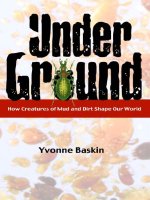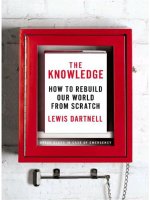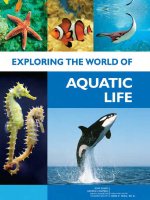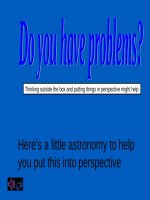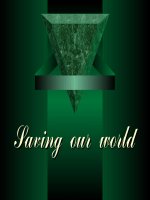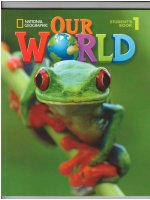exploring our world
Bạn đang xem bản rút gọn của tài liệu. Xem và tải ngay bản đầy đủ của tài liệu tại đây (28.88 MB, 30 trang )
Jacqueline Martin
Read
and discover more
about the
world!
This
series of non-fiction readers
provides
irrteresting
and educationaI
content,
with
activities and
project
work.
Series
Editor:
Hazel
Geatches
ALrdio
CD
Pack
avaitable
Word
count for
this
reader:
r)
\J
r'r\
'l
\.
_/
3,489
A
\ t
f,r?\
\v
L.r'v*[
f,
I
,r'rii
itr
,
()Xl
(
lstll
I
,llllti
$i
Ourr
World
Jacqueline
Martin
Introduction
3
1 Exploring
4
2 Early
Explorers
8
3
Exploring
the Past L2
4 Deserts
16
5 Rivers and Rainforests 20
5 The Arctic and Antarctic 24
7 Mountains 28
8 Oceans 32
Activities
36
Projects
52
Glossary
54
About Read and Discover 56
OXTORD
OXfORD
uNIvt:l(sI1Y
I'luiss
Crert Chren(lon Strect.
()xlr)r(l
()\.r
{,r)l'
Oxford University
l)ress
is
r
(lclrrrtrrrnt
ol
lhc [Jnivcrsity
ofOxfbrd. It firnheB thc
I
Iniv(l
sily
s
ol)ic(l
ive
()l
cxcellence
in research, scholaNhip. rn(l c(lu( rl ion by
publishiug
worldwide in
Oxlbrd New York
Auckland Capeli)wn DircJSrlJrD HongKong Karachi
Kuala Lumpur M:rdrid
Mc'lbourne Mcxico Ciry Nairobi
NewDelhi
Shanghai Taipei lbronto
With omces in
Argentina
Austria Brazil Chile Czech Republic France
Creece GuaterDala Hungary Italy
Japan
Poland Portugal
Singapore South Korea Switzerland Thailand Turkey
llkraine Vietnam
ox!oRD and oxroRD !NGLISH are rcgisterc'd trade marks
ofOxford Univcrsity Pr('ss in thc'UK and in ceftain
other
countnes
o Oxford University l)ress 2olo
'l'he
moral rights ol-thc
iuthor hive been rsserted
l)rtrl)nse
right Oxford [h]iversity Press
(nrnker)
|irst
publishcd
2o ro
2Ot4 2Or3 2Ot2 2O7t 2O7(t
to9876s432
No unauthorized
phottropying
All rights resewctl. No
part
ol this
Publiciltion
ntay be
rcprrxlutcd.
storcd
in a retricval syslenr,
er
traDsntitt!'d,
in any lirrrn or by any nrerns, wilhout
thc'prior
permissioll
i D writ i nu {)l
(
)xli)r(l
I
lniversity
l,ress, or as expressly
l)('rrrillc(l
by
Iiw,
or
under tems ngreed with thc appropriate
r('l)rogrilPhi(
s
rights organization. Enquiries
concerning
rcprorluction outside the scope
ofthe
above
should be sent
to the lllil Rights Department,
Oxford University Press, at
the address above
You must not circulate this book in any
other binding or
cover and
you
must impose
this same condition on any
acquirer
Aly websites
refened to in this
publication
are in the
public
domain and their addresses are
provided
by Oxford
Universiry Press for information only. Oxford Univt'rsity
Press disclaiurs any r('sponsil)ility li)r I he
(\)ntcDt
IsBN:
978
o r(.)
{6J5rrr
}
An /\lr(lro
(
|
)
l',tr L
t onl,ilril[t:
t lils lrrrl<.rtrrl
l
(
ll)
is rls0
,tv.Il.tlrlt t\trN,f
,A
o
t,r
tt, t,,.t0,,
I
lrI
t
I
t
lr.rr.r, lr,,r(
'
,,1
\rr' il,.ilr.rnrl llrrtrrlr
lrrrglislr
rr.,,,rrlrrrr'r,rl
rlrr',,'Irl'1,.1,.
1,.\l
\r
.r,,,'ilr1,.ilr\
ilr1, \, l r\ rt
\
ll',,,j. r\,tl\(',tv,ill,ll)lr'.
r"r'r,r
5"
r,r
lr, l.,rrI
I'r
rnt,,l
rrr
r
lrrrr.r
llr
lrn,l
r.
l'rilrt,.l!11
l'rl,'.t
lr,'lr,r,rltllr\1,il1(l
.r,
ll r",r,,.,,1,'ilr,'
AC K NOWLE DGI M IJ NT S
liiffirrahons |ry: Kelly Kennedy
pp.l3,
17, 24. 33; Dusan Pavlic/
Beehive lllustmtion
pp.36.45.50;
Alan Rowe
pp.36.45,50:
Mark Ruffle
p.8-9,
38
'lhe
l\blishn wouw iko like to thank thc
fdlo$ingfor
thcir
kind
pcmissitm
to rcpreduce
photogrdphs
and oth{ .oryight
mdterial:
Alamy
pp.3 (North
PoleiBryan
& Cherry Alexander
Photography, Teotihuacan/aerialarchives.com), 4
(Nature
Picture Library), 6
(map/Helene
Rogers, CPS/DOZIER Marc/
Hemis), 7
(Sue
CunninghamMorldwide Picture Library),
11
(C.p.
Cushing/Classicstock), 12
{Dennis
Hallinan), 15
(Teotihuacan/aerialarchives.coD),
16
(Frans
Lemmens),
18
(World
History Archive).
27
(Classic
Image). 30
(Peter
Richardson/Roben
Harding Picture Library l.td); The
Bridgeman Art Library
p.2o (Captain
Meriwether Lewis
(
I 774-1809) and William Clark
(
I 77G1838)
on
their
trans-
continental
expedition
fron
the Missouri to the Pacific
Ocean in 1804-05
(oil
on
cinvas).
Burnham,
Thonas Mickc.ll
(
1818-66)/l'dvate
Collection); Constanza Cemti
p.29
(photo
courtesy of Constanza Ccruti/copyright Constanza Ceruti):
Corbis
pp.
l4
(dig/Jiro
Weiping/XinHua/XinHua Press.
Rosetta
Stone/Alfrcdo Dagli Oniflhe Picture Desk Ltd).
l9
(UbariK.M.
Westermann),25
(C.rlen
Rowell). 3l
(Stefen
Chow/Auroru
Photos),33
(Visuals
Unlimited): Cetty Imrges
pp.5
(ClrienjrriD
Chung), 10
(Hulton
Archive), l3
{O.
Louis Milzzatcrrti/National
Geographic), 22(ilCH'l |lSH/l hc lmge Bank). 24
(cordon
Wiltsie/National Ceogrrphic); Mary Evans Picturc
l-ibrary
p.2l
(Mary
Kingsky/Mary Evans Picture
l.ibrary): Meg l.ownrrn
p.23;
Oxford University Press
pp.3 (Iiverest,
rainforest), l5
(rock
paintings),
17, 21
(l;rke
Victoria), 28: l'hotolibrnry
p.26
(Robert
Peary/Photolibrary):
Rick Smolan
p.l9
(Robyn
Davidson):
Science Photo Library
pp.32 (Alexis
Rosenfeld),34
(Rir
Novosti), 35
(Alexis
Rosenle'ld).
Explorers
are
people
who leave
their home
to discover
new
places,
or to
learn new
things
about
people,
plants,
or animals. To learn
more about
our world,
they
go
on exciting
journeys
through forests,
across hot
or
icy
deserts,
up
mountains,
or down rivers.
Do
you
know
about any famous
explorers?
Do
you
know what
places
they
explored, and
r
Where
are these
places?
V
Now read
and discover more
about
explorers
and exptoring
our world!
they
explored,andwhy?
Thousands of
years
ago, early
peopte
knew
about only
a
very small
part
of the world.
Today
we
know
a lot
more,
and
some
of our
information
comes
from
exptorers.
Explorers have changed the
world!
Why
Do People Explore?
Early
people
traveled around to
find food and water.
Most
explorers travel
because they are curious
and want to discover
new
places
and to learn
new
things. Some early
explorers hoped to
get
rich
by
discovering new
plants,
animals, or treasures, and by
selling them when they
got
home. Today,
explorers
travel to have an adventure, to
learn more
about
remote
places,
to find something new to help
science, or
maybe
to
be famous.
Where
Do People
Fr
prlr*r"e?
Early
explorers wanted
to find new
places
or
people.
They
crossed land and explored
deserts, forests, rivers,
and mountains.
Then they
started to explore
the
oceans. Today, many
explorers
want to be the first
to
go
somewhere
a
new
way.
Some try to find
a different
route,
or look for new
ways to travel.
Others want to
be
the
youngest,
the fastest,
or the first
to do something,
for
example,
climb a mountain.
I
h,arlv
cxplorers
uscd
only
the stars
to
flnd
their rn'ay.
Expkrrcrs
wanted
to
sharc what
they found,
sc-r they
wrote
about their
journeys
and
made
maps.
On the maps
they
drew
mountains,
rivers,
and
other
things
that
thcy had
seen, to makc
casicr firr
other
travelers
to follow
It
the same
routc.
Information from somc carl1, cxpkrrcrs has helped
people
to
make
maps to shou'what the world
is like.
The things that thev wrote tell us what
life
was
like
a
long
time ago
in
the
places
that they visited.
Explorers have learned about
new
plants
and animals,
discovered new materials, and learned
new languages.
Thcy have also discovered inventions, and different ways
of
doing things,
for
examplc,
ncw \vays of farming.
Modern explorers
are sti[[ finding new things.
Scientists
hope that in the future, they wit[ find cures
for
many
diseases in the
rainforests
and the
oceans.
Go to
pages
36-37 for activities.
At-rtrr-rt
2,200
vears
ago, Chinesc
people
inventcd
the
c()n-lpass.
A
compass
always
points
north,
sct it
tells
vou
whicl-r
direction
vou are traveling
in.
GPS instruments
that
use satellites
help modern
explorers
to find
out
where
they
are.
ff
i)
t'
,w
\'!',,illt ,r
n,r'
I
,il
n rrill-,r{'.
Early
people
traveled
around
to look
for food,
but
they weren't
exptorers.
Explorers
go
from
their home
land
to discover
something
about
another
place,
and
then
they come
back
and te[[
peopte
what
they found.
People
have
lived in
most
parrs
of the
world for
thousands
of
years.
Scientists
think that
early
people
started in
Africa
and traveled
to Asia.
By
about
401000
years
ago,
there were
people
in
almost
every
part
of Africa, Asia,
and Europe.
By
about
15,000
years
ago
they
moved
into
America.
,l
.,,".
NOBTN
AMEBIET
Zhang
Qian
Marco
Polo
lbn
Battuta
Zheng
He
Bartolomeu
Dias
Christopher
Columbus
Vasco
da Gama
Ferdinand Magetlan
AbeI Tasman
James
Cook
'/,hang
Qian
was an
early explorer
from China.
IIc
explored
many other
parts
of
Asia more than
2,100
years
ago. Other
people
followed
his route to
trade silk
from
Asia with things
from
Europe.
The
route
that
he took
is now called
the Silk
Road.
Marco
Polo was an
explorer
fromVenice,
now
in Italy.
In 1271, he traveled
from
Europe to China.When
he
returned to
Italy 24
years
later, he told
people
about
inventions
like
paper,
money,
pasta,
and
ice cream.
From about
1325
a
Moroccan
explorer,
Ibn
Battuta,
explored North
Africa,
the Middle
East, and
Asia.
He traveled
120.000
kilometers.
IBCTIE OCTAN
West
North
*
fast
PTCIFIC
OCITN
TOUTf,
AMERIEA
INDIAN
OEEAN
PACIFIC
.
OCIAN
ANTANCTICA
SOUTIIIBN
OCEAN
i
-r,,,,
;.;*f*mfl
ffiWpXeXf*fg
Most early
explorers
traveled
over
land,
but later,
explorers
traveled
over the
ocean. The first
explorer
to
sail
from
China was Zheng
He. In 1405, he
sailed
south
to
Indonesia
and then
across the Indian
Ocean
and
down the
east coast of Africa.
A Portuguese
explorer, Bartolomeu
Dias,
was the
first
explorer to
travel west from
Europe
by ship.
In 1488
he
sailed from Portugal
around
the south
of
Africa.
Ten
years
later
another Portuguese
explorer,
Vasco da
Gama, sailed
even
further
and
reached
India.
Christopher
Columbus
was an explorer from
Genoa,
now in
Italy. He
sailed
west
from
Europe. He
reached
the'West
Indies in
1492
and thought he
was near India,
but he
was
near
a
place
that no
one
in
Europe knew
about
-
America!
A
Portuguese explorer called
Ferdinand Magellan
was the
first
explorer to
travel to Asia by sailing west
from
Spain.
In 1520 he sailed around South
America
and across the Pacific Ocean.
In 1616, some
Dutch
explorers
discovered the west
of Australia.
In 1642
another
Dutch sailor called
Abel
Tasman
discovered
New Zealand.
Antarctica was the
last
continent
to
be
explored.
A
British
sailor called
James
Cook explored a
lot
of
places.
In 1773, he was the
first
explorer to
cross the
Antarctic Circle, but
he
didn't see
Antarctica. People
think
that the first explorers to
land
on
Antarctica were
led by a Norwegian explorer called
Henryk Bull in 1895.
Go
to
pages
38-39
for
activities.
There
are
lots
of
people
who
explore
the
past.
This
helps
scientists
to understand what is
happening
on Earth
today.
Geologists are scientists
who study rocks
to learn
how Earth
was made
and how it has
changed. They
discovered
that Earth is made
of hot liquid rock
that
is
covered
by big
pieces
of solid
rock
called
plates.
The
plates
can
move,
and when
they crash into
each
other, they
can
push
up and make
a mountain
or a
volcano,
or
they can cause an
earthquake.
Scientists
study how
the
plates
move
to try
to tell when
earthquakes
will happen
or when volcanoes
will erupt.
When
ancient
plants
and
animals
died,
they
were
buried
under
sand
and
mud.
After a
long
time,
they
went
hard and
changed
into
fossils.
Paleontologists
are
scientists
who
study
fossils
to
learn which
plants
and
animals
lived on
E,arth
in
the
past.
They
hetvc
discovered
fossilized
plants
and
bones,
tccth'
cggs,
atlcl
shells
from
fish, birds,
insects,
and
other animals
tl-rat
lived up
to 500
million
years
ago.
These
discoveries
give
us
information
about
animals
that
lived
a
long
time
ago
-
like dinosaurs!
r/
ff6q-
\(}/ Scientists
have
found fossits
of
ocean
animats
at
the toP
of Mount
Everest.
This
means
that
the
rocks
on
Mount
Everest
were
once
under
the ocean
and
were
Pushed
uP.
1
Archaeologists
study
ancient
placcs,
buildings,
bones,
or objects,
to learn
about how
pcc-rple
lived
in
the
past.
These
things tell
us what skills
and materials people
had,
what
they believed,
and
what
clothes
they wore.
Some
old buildings,
like
the
Great\Wall
of China,
are
easy to
see. Sometimes,
the things
that archaeologists
look
for havc
becn
buricd for
a
long
time, and
thcy
have
to dig them
up very
careful
dszsC\d>
(=If
',
-li
\f/
The
discovery
of the Rosetta
Stone
in Egypt
was
very important.
It
hetped
peopte
to
understand
the
Ancient Egyptian
atphabet
and to
learn about
tife in
Ancient
Egypt.
Many
ancicnt
buildings and
objccts
have becn
found in Ccntral
An-rerica, for cxample,
in Mcxico.
By studying thcsc
discovcrics, archaeologists
havc
learned a
lot
about
how the
May'an
pcoplc
livcci
abclut
2,000
years
ago, and
how
the
Aztcc
1-rcoplc
lived about 500
years
ago.
At Mohcnjo Daro)
now in Pakistan,
archaeologists
have found houses
from 4.500
vears
aso with
toilets
and bathrooms!
Many important
discoverics
have also been
found
in cavcs.
In 2009. an archaeoloeist
=.:
called
Quirino
Olivera
found cave
,'
paintings
more than 6,000
years
:.
olcl in
tl-re
Andes. Cave
paintings
at lilkaclu National
Park
in
r\ustralia
tcll
archaeologists
about
Ircr,ple
uncl
animals
who
lived
llrt'r't'
r.rl)
l()
23,000
years
ago.
(ro
lo
lr.rges
40-41 for
activities.
A
desert
is
an area
of
land where less
than
25
centimeters of rain fa[[s
every
year.
At
the
moment
about 3O% of the tand on Earth is
part
of a desert, but
deserts are
getting
bigger.
There
are
four
types of desert. They form in
different
ways near
the equator, near the
ocean,
near mountains,
or
inland.
Only
25%
of deserts are sandy, and the rest
are
made
from
stones.
All
deserts are very dry,
but they
can
be hot or cold. Antarctica
is a desert. It's very
cold,
but it
doesn't snow there very
often.
The largest
hot
desert in
the world
is
the Sahara Desert in Africa.
People
have explored
deserts
for
many
ycllrs.
Ilarlv
desert
explorers
went
to
find things
ttl trltclc,
()l'
llt'\\'
trade
routes. Not
much
grows
in thc clcscrt,
l-rttt
underground
there can
be salt,
oil,
gold,
ttr
prcciotts
stones
like diamonds.
Today,
explorers
want to
lcltrt't
about
the
people
who
live
in deserts, and
some
just
want an
adventure!
Archaeologists
have
found
villages buried
under
the
sand.
In
1922 an
American
explorer,
Roy
Chapman
Andrews,
found
lots
of dinosaur
bones
in
the
Gobi
Desert
in Mongolia.
4rc
L:lD
"d
\3/
Explorers
keep discovering
new things
in the desert
because
the
wind
btows
the
sand
around
and
chartges
the
[andscape!
?
,di*{i#Mdln
Desert
Explorers
Many
early
desert
explorers
wanted
to be
the first
to travel
all
the way
across
a desert. The first
person
to travel
across
the
Sahara Desert
was
a French
explorer
called
Ren6
Caill6. In 1828
he
traveled
across
the Sahara
with
camels because
they
can
walk a long
way
without food
or
water.
In
1887
a British
explorer,
FrancisYounghusband,
crossed
the Gobi Desert
in
70
days. The first
women
explorers
to cross
the
Gobi Desert
were British
explorers,
Mildred
Cable,
Evangeline
French,
and
Francesca
F'rench,
who
traveled
in
a
mule-cart
in
about 19261
The first
European
explorers
went
to
the coast
of
Australia,
but no
one knew
what
was in the
center.
In
1860
two British
explorers,
Robert
Burke
and
tVilliam
Wills,
and an
Australian
explorer
called
The
first
woman
explorer to cross the
Australian
l)cscrt
from
east to west
was an Australian
explorer callcd
Robyn Davidson.
In 1977 she traveled
2,735 kilometcrs
by
camel from
Alice
Springs
in central
Australia
to the west coast.
In 1992,American scientists
discovered the'lost'
ciw of
Ubar
on a space
radar
image. Then some
explorers
led by a
British explorer,
Ranulph
Fiennes,
went to
find
the
city
in
the desert
in
Oman.
John
King,
were
the first
explorers
to
cross Australia
from
the
south to
the north.
They
brought
camels
from India
to help
them.
Many
parts
of the
world
are hard
to explore
because they
are covered
by
rainforests
or
mountains. Explorers
often
travet
by river
to
get
to some of these
places.
In the
past,
some
governments
gave
explorers money
if
they found
an easier route
to another country,
because their country
could
then earn money
by
trading
things. In 1804,
American
explorers,
Meriwether Lewis
and
tVilliam
Clark, explored
the
Missouri River
to look for
a
new
trade route
to the
Pacific
Ocean.
It
took them 1B
months,
but they
made it!They
drew maps
and
wrote about the
things
they
saw and the
people
they met. In I
542 a Spanish
explorer
called Francisco
de Orellana sailcd
down
the Amazon
River from its
source to tl-rc Atlantic
Ocean. He found
lots of new materials
t() trade.
In 1895
a British
explorer
called
Mary I(ingsley
traveled
along
the Ogowe
River in
Africa
to lcart-t
about
the
people
there.
She also
found
many
ltcw
types
of
fish!
Lots of
river explorers
wanted
to be
tl-rc
llrst to
lirttl
the
source
-
where a
river starts.
Many
explorcrs
hltvc
tried to
find the source
of
the
Nile
River in
Afiica
the
longest
river
in the world.
They
have all
returncd
with different
ideas.
Scientists
stit[ don't
atl agree
where the
source of
the Nite
is, but
most
people
think that it's
Lake Victoria,
Amazing
Bainforests
Rainforests
are very important.
They
only cover
6%o
of the land
on Earth,
but
more
than half
of all
rypes
of
animal
and
plant
on Earth live
there.
Some rainforest
trees have
more flowers
and fruits
than
any other
trees
in the
world.
Some medicines
that
we use are made
from
plants
from
the rainforests,
and
scientists
think
there
are lots more
plants
to
be discovered.
Sugar,
chocolate,
coffee,
chewing
gum,
rubber,
and
Rainforest
Explorers
Many
rainforest
explorers
are
scientists
looking
for new types
of
plant
or animal.
In about
1800 a
German
explorer,
Alexander
von
Humboldt,
and
a French explorer,
Aim6
Bonpland,
looked
for
new
plants
in the
South
American
rainforests.
They
returned
with
new
information
about
people
and
wildlife.
In 1848
two
British
explorers,
Alfred Russel
\Tallace
and
Henry
Bates,
went
to
Brazil to
look
for
new insects.
Snakes
and
insects bit
them and
some
people
shot at
them, but
they
found
L4,712 types
of
insect
including 81000
new ones!
In the
past,
explorers
only
moved
along
the
ground.
Today, explorers
like this
American
scientist,
Meg
Lowman,
use special
ropes
to climb
trees
and explore
the top
of the
rainforest.
many
fruits,
nuts,
and spices
come from rainforests.
)
Go to
pages
M-45 for activities.
The
Arctic
and
Antarctic
were
the [ast
places
to
be
exptored.
Early
explorers went
to see what was
there,
and later,
others went
to look for
the
minerals
and
ocean
animals
that were found
by earty
explorers.
ffi*me
h$mq &&xm
ffi*$*s
Early
explorers
wanted to
be first
to reach
the ends
of the Earth
-
the Poles.
Modern
explorers
rry ro
get
to the Poles
more
quickly
or by using
different
vehicles,
for
example,
a
hot-air
balloon.
Near the Poles,
the
sun
doesn't
go
down in
summer
-
this is
ca[[ed
the midnight
sun.
What's
at
ths ffm$*s?
The
Arctic
is like a
giant
ice cube!There's
no land
there
-
just
ice and
water.
The
Antarctic
has
land, too
-
it's called
Antarctica.
In the
past,
the
Antarctic
was
warm.
Scientists
have
found
fossils there
of the
same
plants
and
animals
that they
have
found
in Australia
and
South
America.
They
also
found
fossils of eight
types of dinosaur!
Today
there
are lots of
scientific
research stations
in Antarctica.
Scientists
study
the
wildlife,
ice, fossils,
weather,
and climate
to
help us
to
understand
more about
Earth.
There
are oil,
gas,
and
minerals
under
both
places,
but they
are
hard
to
get
to through
the
ice.
l'i,'.;1,;,,,ili-:]i'i,:'ii:i''r,"':
,'
The first Arctic
explorers came from Asia. They
wanted to
find new
land to live on and
animals to
hunt. The first European
explorers
arrived
in
about
1500. They
were
looking
for a shorter trade route to
Asia from
Europe through
the
Arctic.
In 1728,
a
Danish
explorer,Vitus Bering, was the first
explorer
to
find
the Northeast Passage around Russia.
In 1906,
a Norwegian explorer, Roald Amundsen,
found
a way around the top of Alaska
-
now
called the
Northwest Passage.
Most
people
believe that the first explorer to
get
to the
North Pole
was an
Ameri
in 1909.
xplorer, Robert Peary,can e
I
Roald
Amundsen, and
a
British explorer,
Robert
Scott,
raced to
be f,rrst to
the South
Pole.
Amundsen
got
to
the
Pole
first in December
191
I . He used skis
and dog
sleds,
and
returned safely
with all
his
men.
Scott's
men walked,
pulling
everything
on sleds.
They
got
to the
Pole a
few weeks
later and
found that
Amundsen's
Norwegian
flag was already
there.
Sadly,
Scott
and
his
team
died on
the way
back.
The first explorers
to cross Antarctica
were
led by a
British explorer
calledVivian
Fuchs
in 1958.
In 2001
an American
explorer,
Ann Bancroft, and
a Norwegian
explorer,
Liv
Arncscn,
wcre the
first women to
cross it.
Go
to
pages
46-47 for activities.
&i1u
.:', !,*
il'.,:i':,'
Mountains
cover about
25%
of
Earth. They
are
made
of
rocks
and soi[,
and they are
much
higher
than the land
around
them.
They form
when underground
plates
crash
together and
push
the land up. This
takes
millions
of
years.
& **,
* r*
-
*
r*,
*
!: ; i':
*,*
: :, l,r
i:
!: ii;
:
.':
:;
The
biggest mountain
chain is the Himalayas in Asia.
Mount
Everest, the highest
mountain in the
world,
is in
the Himalayas.
Everest is
still
growing
about
5 millimeters
every
year.
The longest mountain
chain is
under the ocean!
The Mid-Atlantic
Ridge
under the Atlantic
Ocean
is
16,000 kilometers
long. The longest mountain
chain
on land is
the
Andes
in South America.
Geologists
look at
the
rocks
in
mountains
to
learn
more about
how
Earth was
made.
Some
mountain
explorers
have found
metals
like
gold,
silver,
copper,
and tin.
They
have also
found
precious
stones
like rubies
and
emeralds,
and
rocks,
like
granite
and
limestone.
Some
mountain
plants,
like the snow
lotus, are
used
to
make
medicines.
Mountain
archaeologists
look
for ancient
remains on
the
top of
mountains.
In I 999,
Constanza
Ceruti
from
Argentina
was
exploring
6,739
meters
high at
the top
of
the
Llullaillaco
Volcano
between
Argentina
and
Chile.
She and
Johan
Reinhold
found
food
pots, gold
and
silver
statues,
and
three
Inca
mummies
that
were
500
years
old.
'l'he
first
people
to
get
to the top
of Mount Everest
were Edmund Hillary from New Zealand and
Tenzing
Norgay
from
Nepal
in 1953. About 2,000
people
have
climbed
to
the top of Everest, but
more
than
200
of
them never returned. Modern explorers try and
find
new ways to climb it.
The first woman
to
get
to the top of Everest was a
Japanese
climber
called
Junko
Thbei in
197
5.
In 1992
she also became
the first woman to climb the
highest
mountain in each of the seven
continents.
Mountain
explorers
often
want
to be
the
first
to
climb
a
mountain.
A Frenchman
called Antoine
de
Ville
climbed
Mont
Aiguille
in
the
Alps
in 1492.
Later,
some
people
gave
explorers
money
to
climb
mountains
to
see
what
was
there.
Michel
Gabriel
Paccard
and
Jacques
Balmat
climbed
Mont
Blanc
for
a
prize
in
1786.
Another
French
explorer
called
Marie
Paradis
was the
first
woman
to climb
Monr
Blanc
in 1808.
{.
,On.
youngest
person
to climb
Everest
'a
Nepatese
gir[
catted
Ming Kipa
Sherpa.
She ctimbed
it
with her brother and sister
r,,;:f
t
15
years
old.
y;,,:;
iy'),,,,.
ooroo^n"fff,i,ff'y',ffi
After
exploring most
of the [and,
people
started to
explore under
the oceans. The
oceans are enormous
-
they cover about 70%
of
Earth. There
are
sti[[ thousands
of kitometers
of seabed to
be explored.
There
are five
oceans, but more than half
of all the
water in
the oceans is in
just
one ocean
-
the Pacific
Ocean. At first,
scientists thought
that the seabed
was
flat,
but now
we know that
there are mountains,
valleys,
volcanoes,
and
plains
under
the water. By
studying
the seabed,
scientists have learned
that the
oceans started
to
form
41000 million
years
ago. They
have found
bones
from
land
animals on the
seabed,
which
shows
that the sea level is much
higher now.
'
"
''
':i:::''r-il:
:
The oceans
are
full of amazing
plants
and
animals.
Some
ocean
plants,
like seaweed,
can
be used
ttr
make
medicines.
Today, scientists
know
about
25,000
different
types
of
fish.
They
find more
than
100
new types
every
year.
There are
lots of
precious
things
in the oceans.
Pearls
are
jewels
that
can
form
inside oyster
shells.
There
are
metals
like
gold,
iron,
and copper
in the
seabed,
too.
More
than
20% of
all
the oil that
we
use comes
from
under
the
oceans.
the oceans
to cover
Earth
with up
to
150
meters of
salt.
I
t
rsffi*
.zr.
-l=!\^
{}r-qlr,:
l; ,,
Early
ocean explorers
could only explore for
as
long
as
they could breathe. In
1943, two Frenchmen,
Jacques
Cousteau and Emile
Gagnan, invented
Self Contained
Underwater Breathing
Apparatus
(SCUBA).This
allowed divers to stay
underwater for longer
and dive
deeper than ever before.
In 1960,
a Swiss explorerrJacques
Piccard,
and an
American,
Don\7alsh,
dived
down almost 11 kilometers
in a small
submarine to the
deepest
part
of
the
Pacific
Ocean. It's the
deepest that
anyone has dived.
No one
thought anything
could
live
that far
down, but they
found
some new types
of
fish.
An American
explorer called
Silvia Alice Earle
holds
'#h,rf *{*xi:
Modern explorers
have better equipment
and
they can
explore
further than
ever before, but
they don't
even
have to
go
anywhere.
Today
we
can send
robots to
explore
places
and bring back
information!
The oceans
are the
least explored
part
of Earth, but
there are still
things to
find in rainforests,
mountains to
climb,
and
thousands of
places
to explore. What
part
of
our world
woulcl
you
like to explore?
the
record
for the
deepest woman
diver in
a
submersible. She has
spent more
than 71000
hours
underwater.
Go to
pages
50-51
for activities.
T
Exploring
3 Order the
words.
+
Read
pages
4-7.
1 Write
the words.
map
ffiorffitain
compass
sateltite
river
forest
1
mmuntuin
2
Write
true or false.
1 Explorers
have
changed
the wortd.
2 Early
peopte
traveled
to find
food.
3
Explorers
aren't curious.
4 Explorers
want to
discover
new
p[aces.
5
Some earty
exptorers
hoped
to
get
sick.
6 Some
earty
explorers
wanted
to find
new
things
to
se[t.
Some exptorers
want
to
be last to find
something.
Some
explorers
want
to be famous.
?nmm
3
tand
/
They
/
crossed
/
oceans.
/
and
/
explored
4 to
/
want
/
new
/somewhere
/
a
/
Explorers
/
go
/
way.
5 travel./Some/took
/ways/for/
new
/
exptorers/to
6
be
/
others
/
to
/
want/something./
the
/
to
/
fastest/do
Complete
the sentences.
instruments
maps mountains
s'tafs
rivers compass
north
1 Early exptorers
used
the starg
to
find their
way.
2
Explorers wrote about
their
journeys
and
made
3
They drew
and
on the
maps.
4 About
2,200
years
ago
Chinese
people
invented the
5
A
compass
always
points
1 explorers
/
Early
/
find
/
new
/
wanted
/to
/
places.
Sart-{ sspt#rfl"{.*,
qa;}qnhm.*{
tm find
new
D[a6eB.
2 deserts,
/
They,/
mountains.
/
exptored
/
rivers,
/
and
rr
6
Modern exptorers
can use
GPS
Match.
Then
write
comptete
sentences.
Early
Explorers
+
Read
pages
8-11.
1
Write
the
words.
Antarctica
North
America
Asia
Africa
Attantic
Ocean
pacific
Ocean
Europe
South
America
Indian
Ocean
Vasco da Gama
Ferdinand Magetlan
Abe[
Tasman
from Europe to
Asia
to New Zeatand
to the Antarctic
140s
1488
L492
1498
L520
L642
L773
1895
Correct
the
sentences.
1
Early
peopte
traveled
around
to
took
for
rocks.
2
Zhang
Qian
was
an
earty
exptorer
from
Europe.
3
Marco
Polo
traveted
from
Africa
to
China.
lbn
Battuta
exptored
North
America,
the
Middte
East,
and
Asia.
ln
t405.
Lhonq He
travelod from
Lhina
lo
Oasl
Africa.
4
Which
explorer do
you
think
was
the
most important?
whv?
1
2
3
4
5
6
7
8
9
1
2
Zheng Ha
from Europe to India
James Cook
\ from
China
to East Africa
Bartotomeu
Dias
Henryk Butt
Christopher Cotumbus
from
Europe
to America
from
Europe to
Africa
to Antarctica
T
Exploring
the
Past
C
Read
pages
!2-t5.
Circle
the
correct
words.
1
Exploring
the
past
hetps
scientists
to read
/fu-i6f gr]
what
is
happening
today.
Geotogists
study
weather
/
rocks
to
learn
how
Earth
was
made.
Earth
is
made
of
pieces
of sotid
rock
catted
cups
/
ptates.
When
the
ptates
crash
they
can
cause
an
earthqu
ake
t
a
storm.
5 Paleontologists
study
buitdings
/
fossits
to
learn
about
ptants
and
animats
in
the
past.
6 Fossits
give
us information
about
ptants
and
ptates
/
animats
from
a
[ong
time
ago.
Complete
the
sentences.
exptore
the
past
make
a mountain
on
Mount
Everest
earthquakes
wilt
happen
under
the
ocean
3
Comptete the
chart.
wore made fossils
ffis
rocks
archaeotogists animals
paleontologists
3
4
Who?
qeoloqists
_J_'-
What
do they
find
or study?
ancient buitdings
or objects
What
does this tett us?
how Earth was
and
how it
changed
which
plants
and
[ived a long time ago
what
peopte
did, believed,
and
1
2
3
4
5
There
are
lots
of
peopte
who
When
plates
crash,
they
push
up
and
Scientists
study
ptates
to
tett
when
Pateontotogists
have
discovered
fossits
The
rocks
on
Mount
Everest
were
once
Answer
the
questions.
1 What did the Rosetta
Stone
hetp
people
to
understand?
tt
hslped
lhem to
undsrstand
tha Ancient
6$ptian
alphabet
2 Where was the Rosetta
Stone
found?
What have archaeologists learned from ancient buitdings
in Mexico?
4 How otd were the houses found in Mohenjo Daro?
5
What have
archaeologists
found in Kakadu National Park?
6
Where did
Quirino
Otivera find
paintings?
Deserts
+
Read
pages
16-19.
Complete
the sentences.
1 At
the moment
about
qA'/,
of the land on Earth
of a desert.(30%
/
50%)
2 A
desert is
an area
of
land
where
25
centimeters
of
rain
fatls
every
year.
(tess
/
more)
Deserts
are
getting
(smatler
/
bigger)
There
are
_
types
of desert.
(four
/
five)
Only
25%
of deserts
are
.
(rocky
/
sandy)
A1[
deserts are
_,
but
they can
be
hot
or
cold.
(dry
/
wet)
7 The
largest
desert in
the world
is the
Sahara
Desert.
(cotd
/
hot)
is
part
than
under deserts.
buried under
the sand.
dinosaur
bones in the
Gobi Desert.
for many
years.
find new
trade routes.
about
the
people
who
live in deserts.
an adventure.
1
Good things about being
i
_
'9g1"ilglq!g_11'
_-
lyou
coutd
find
i something
-
I
jvou
coutd become
Bad things about being
a desert exptorer:
it's easy to
get
it's very
_
or
very
cold
Correct the sentences.
1 Many earty desert explorers
went to find deserts to trade.
2 Ren6 Caitt6 traveled across
the
Sahara
Desert by train.
3 Camels can
walk a long way without
food
or clothes.
4 Francis
Younghusband
crossed
the
Austratian Desert.
5
Robyn Davidson crossed the Sahara
Desert int977.
Complete the chart.
new famous lost
hot
2
1
2
3
4
5
6
Match.
People have
explored
deserts
Some
early desert
explorers
went
to
Some
explorers want
to learn
Some explorers
want
There
can be salt,
oi[, or
gold
Archaeologists
have
found
villages
An
American
explorer found
3
4
5
6
5
Woutd
you
like to be a desert explorer?
Why
/
Why
not?
rf
Rivers
and
Rainforests
on Earth.
on
Earth
t tDices
Answer the
questions.
1 What
are
many
rainforest explorers
looking
for?
Which river did
Meriwether
Lewis and
Witliam
Ctark
exptore?
Where is
it?
3
What did
Mary Kingsley
find in the Ogowe
River?
What did Atfred
Russel Wallace and
Henry Bates
find
in Brazi[?
o
4"w
o
&t#
Ro
od6
3 Find and
write
the
words.
o
ffi
+
Read
pages
20-23.
Write
true
or
false.
1
Countries
can
earn
money
by
trading
things with
each
other.
Governments
sometimes
gave
explorers
food if
they found
a new route.
Lots
of explorers wanted
to
be the first
to find
the source
of a river.
The
River Nite is
the [ongest
river in
the
world.
Comptete
the sentences.
[and rainforest
flowers
ctimb
discover
ptants
Rainforests
cover 6%
of
the
3
6
2
54
7
1
2
3
4
5
6
More than
half
of
the
animals
and
live
in rainforests.
Rainforest
trees have
more fruits
and
other
trees.
Some medicines
are made from
than
ptants.
Scientists think that
there
are more
plants
to
Modern rainforest
exptorers
use speciaI ropes
to
s
m
E
p
c e
3
o
r
p
e a
r t a x
n
b
u
e
d k a u
t e
g
n b
s i I d
t
c
t
t u b
u c
h
o
c o t a
t e
g
i c o e
t f
V
s
r
a
n h
p
w t
r u i t
I
e o
s s e a
t
m
5
o s b
I o e
r s
o
o
c
h
e
W
I n
g
g
u
m
the
trees.
FF'
d
w
4:
Read
pages
24-27.
1
comptete
the sentences.
-see
quickty
minerals
Antarctic
ends
vehicles
exptored.
2
Early
exptorers went
to
_
what was
there.
3 Later,
other exptorers
went to
look for
and
ocean
anima[s.
4 Early
explorers
wanted to
be first to reach
the
of the Earth.
5 Modern
explorers
try to
get
to the Poles more
or by using
different
P. Write
Arctic
or Antarctic.
1 In
the
past,
it was
warm.
2 lt has
land.
3
lt's
tike
a
giant
ice cube.
4
Scientists have found
fossils
there.
5 The
first explorers
went there from
Asia.
6
There
are
lots of research
stations
there today.
7 The
North Pole
is there.
8 The
South
Pole
is there.
t
f,+;: .&rtrtiffi
&ffid Arttmr"e€.$a.
3 Match'rhen
write comprete sentences'
found the
Northwest
1500
Vivian
Fuchs
passage
t72g
Roald
Amundsen
crossed
Antarctica
1906
European explorers
were the first
women
1909
Robert Peary
to cross
Antarctica
1 The Arctic
and
_
were the
last
places
to be
1911
Roal.d Amundsen
reached the Arctic
195g
Ann
Bancroft and
sailed into the Northeast
Liv Arnesen
Passage
2001
Vitus Bering
reached the
South
Pote
reached
the North Pole
4 Would
you
like to be a
polar
explorer?
Which Pole
would
you
visit? Why
/
Why
not?
llF"


